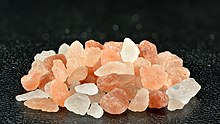Sal do Himalaia
halita do Paquistão
O sal do Himalaia é um mineral extraído de uma rocha salina, ou halita, oriunda da região do Punjab, no Paquistão.


Inúmeras alegações de saúde têm sido feitas sobre sal do himalaia, mas não há nenhuma evidência científica de que seja mais saudável do que o sal de cozinha. Tais alegações são pseudocientíficas.[1][2][3][4][5][6][7]
Ver também
editarReferências
editar- ↑ Julianna LeMieux (24 de janeiro de 2018). «Pseudoscience Is Everywhere - Even The Gift Shop Of The American Museum Of Natural History». The American Council on Science and Health. Consultado em 29 de setembro de 2018
- ↑ Sipokazi Fokazi (30 de outubro de 2017). «Himalayan salt: Benefits of staying in the pink». Independent Media, South Africa. Consultado em 29 de setembro de 2018
- ↑ «Do Salt Lamps Provide Multiple Health Benefits?». Snopes.com. 8 de abril de 2018. Consultado em 8 de abril de 2018
- ↑ «David Avocado's Himalayan Salt Debunked». Bad Science Debunked. 18 de janeiro de 2016. Consultado em 20 de julho de 2017. Cópia arquivada em 21 de julho de 2017
- ↑ Bastos, Anne Borges de; Carvalho, Hugo Rafael do Amaral; Silva, Cláudia Cândida; Araújo, Lídia Medina (2 de janeiro de 2017). «Análise e comparação da composição química inorgânica do sal de cozinha com o sal rosa do Himalaia pelo método de fluorescência de raios-X por dispersão de ondas.». The Journal of Engineering and Exact Sciences. 3 (4): 0678–0687. ISSN 2527-1075. doi:10.18540/jcecvl3iss4pp0678-0687
- ↑ Schwarcz, Dr Joe (2019). A Grain of Salt: The Science and Pseudoscience of What We Eat (em inglês). Toronto: ECW Press. p. 281. ISBN 978-1-77305-385-1.
As is often the case with nutritional controversies, pseudoscience slithers into the picture. In this case it is in the form of “natural” alternatives to table salt with insinuations of health benefits. Himalayan salt, which is composed of large grains of rock salt mined in Pakistan, is touted as a healthier version because it contains traces of potassium, silicon, phosphorus, vanadium, and iron. The amounts are enough to color the crystals, giving them a more “natural” appearance, but are nutritionally irrelevant. Some promoters make claims that are laughable. Himalayan salt, they say, contains stored sunlight, will remove phlegm from the lungs, clear sinus congestion, prevent varicose veins, stabilize irregular heartbeats, regulate blood pressure, and balance excess acidity in brain cells. One would have to have a deficiency in brain cells to believe such hokum. It doesn’t even rise to the level of taking it with a grain of salt.
- ↑ Isabela Pires Loyola (8 de julho de 2020), Comparação entre os efeitos do sal do Himalaia e sal comum nos valores de sódio urinário e pressão arterial de indivíduos hipertensos, Goiânia: Faculdade de Medicina da Universidade Federal de Goiás, Wikidata Q108029658
Ligações externas
editar
|